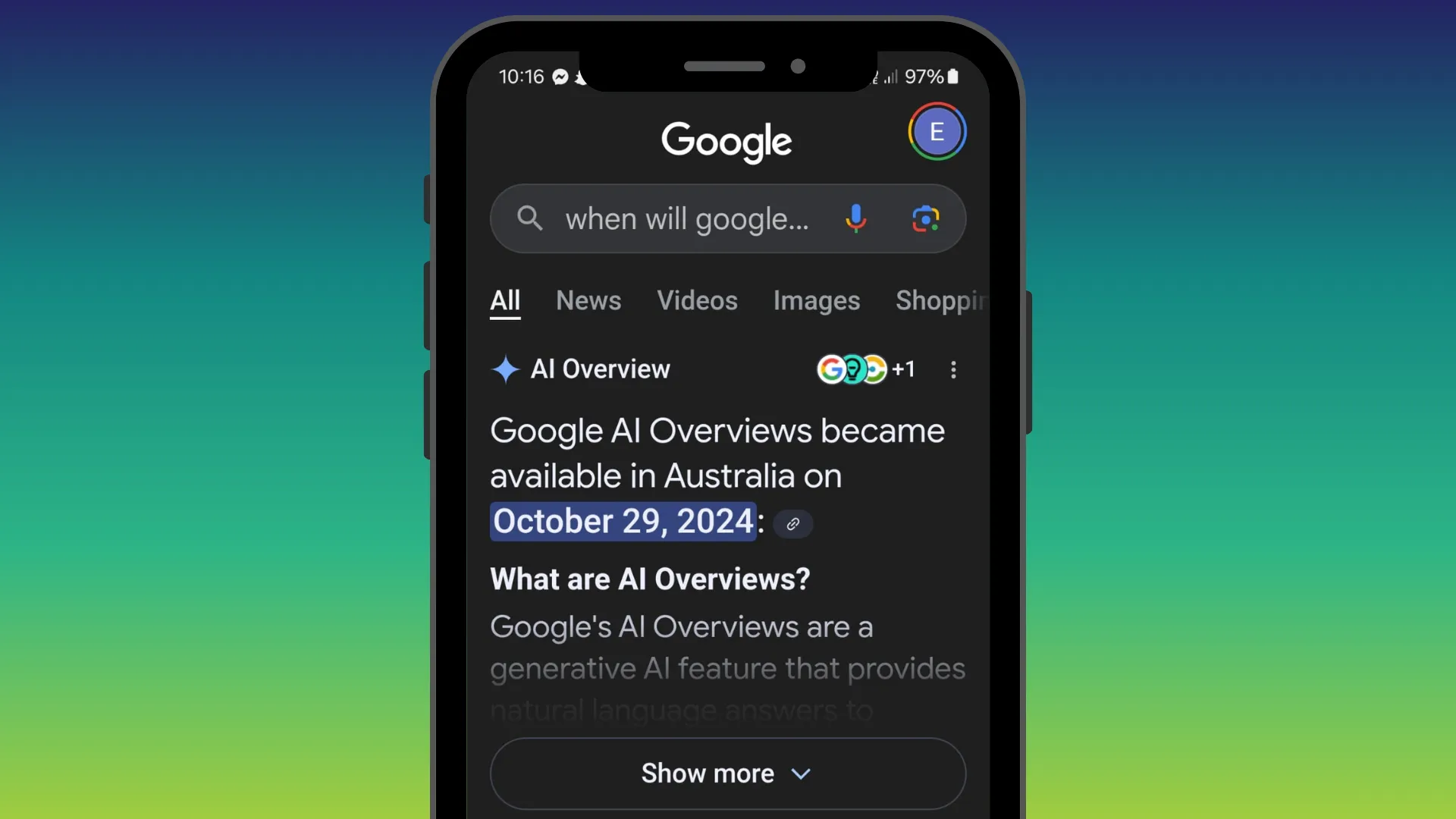Google’s new search feature, AI Overviews, has recently launched in Australia, transforming how we interact with search engines. With AI-generated summaries now appearing directly in search engine results, brands need to adapt to remain visible. These summaries provide quick answers to user queries, meaning that traditional search engine optimisation (SEO) tactics are evolving to suit this new AI-driven landscape. To stay competitive, it’s crucial to optimise your website for Google AI Overviews.
What are Google AI Overviews?
AI Overviews bring the power of generative AI to Google’s regular search functionality, creating quick summaries and contextual responses to user searches. Positioned above traditional search results, these summaries present the information users seek directly on the results page, limiting the need to click through to individual websites. This shift reflects a ‘zero-click’ approach, where users can receive direct answers without leaving Google, altering the dynamic between content creation, users and search engine interactions.

Learn more about the ‘zero-click’ future.
How to optimise your website content for AI Overviews
Optimising for AI Overviews requires a fresh approach to content creation. Here are the key steps to ensure your content is primed for these AI-generated summaries, keeping it engaging for both Google and the end user.
1. Produce high-quality, relevant content
Creating valuable, accurate content has never been more important. Here’s how to ensure your website content remains Google-friendly:
- Focus on user intent: Understand the questions and needs of your target audience. Tailor your content to address those specific queries and concerns directly.
- Provide detailed answers: AI Overviews prefer in-depth, complete answers to common questions. Aim to cover topics thoroughly and in a way that’s digestible for readers.
- Ensure content accuracy and credibility: Build trust by sourcing information from reliable places and ensuring that your content is well-researched. Trustworthy content not only resonates with your audience but is also favoured by AI algorithms.
- Incorporate Google’s E-E-A-T Principles: Google values content that demonstrates Experience, Expertise, Authoritativeness and Trustworthiness. Demonstrate your industry knowledge and offer practical insights that reinforce your credibility.

2. Use effective keywords and language
Google’s AI is built to understand both the context and intent behind user queries so using natural, conversational language and well-researched keywords is crucial. You can achieve this by:
- Prioritising long-tail keywords: Long-tail keywords are more specific than general keywords and are better suited for conversational search queries, making them a natural fit for AI-generated summaries.
- Utilise semantic search techniques: Go beyond keywords to incorporate related terms and phrases, helping your content to appear in a broader range of searches.
- Adopt a conversational tone: AI Overviews favour content that reads naturally and conversationally. Use approachable language to make your content resonate and appear more relevant.
3. Make your content clear and concise
Simplicity and clarity are essential to user experience and visibility in AI Overviews:
- Write clearly and concisely: Avoid complex terminology and aim to explain topics in simple terms, ensuring accessibility to a wide range of readers.
- Use a logical structure: Break up your content with headings, subheadings and bullet points to guide users through your content efficiently. Use this article as an example.
- Proofread carefully: Ensure your content is free of errors to maintain credibility. Typos and mistakes can detract from both user experience and AI processing.
4. Implement structured data and schema markup
Structured data and schema markup provide essential context for search engines, helping Google better understand your content’s structure and intent:
- Use structured data to organise content: This code helps Google classify and display information accurately, boosting the likelihood of appearing in AI Overviews.
- Add schema markup: Tools like Google’s Structured Data Markup Helper can guide you in implementing schema markup which makes your content more visible to Google’s AI, improving the chances of it being highlighted.

5. Leverage visual and multimedia elements
Visual content enhances engagement and can increase the time users spend on a page – positive signals that Google factors into its algorithms.
- Incorporate visuals: Use images, videos and infographics to break up large text blocks and add value. Visual aids can clarify complex topics and keep users engaged.
- Optimise for page speed: Large files can slow down page loading times, which negatively impacts user experience. Make sure all visual content is optimised for fast loading.
![]()
6. Focus on user experience (UX) and mobile friendliness
Beyond AI Overviews, creating a smooth and mobile-optimised user experience is essential for retaining visitors and reducing bounce rates:
- Prioritise ease of navigation: Ensure your site is intuitively designed, with fast loading times and a logical structure.
- Optimise for mobile users: With more people accessing content via mobile devices, a responsive design that adapts to various screen sizes is crucial for user satisfaction.
Stay ahead of your competition with content optimisation
As AI Overviews continue to shape the search landscape, optimising for these features is key to staying relevant on Google. Focusing on high-quality, user-centric content and a positive user experience will help your website remain competitive as search technology evolves. Staying ahead of your competitors requires staying informed and proactive in your SEO strategies. If you’re ready to take the next step in optimising your content for Google AI Overviews, reach out to us today to learn how we can support your SEO goals.

Google’s new search feature, AI Overviews, has recently launched in Australia, transforming how we interact with search engines. With AI-generated summaries now appearing directly in search engine [...]

When you think about it, Pinterest is not really a social media platform but more of a search engine. While it does allow users to follow and [...]

One of our biggest takeaways from State of Social 2024 was the evolution of zero-click searches and the impact it will have on the way we do [...]

Have you noticed a drop in engagement on your brand’s Instagram posts? Likes not flowing as much as what they used to? The good news is you’re [...]

Last week, Facebook announced a major update: 'Views' will now replace impressions as the primary metric for posts and Stories. This change aligns with Instagram's recent metric [...]

It’s the second week of November, and Black Friday promotions are in full swing; emails, ads, organic posts. But, how many of these promotions are you actually paying [...]

Google’s new search feature, AI Overviews, has recently launched in Australia, transforming how we interact with search engines. With AI-generated summaries now appearing directly in search engine [...]

TikTok can be polarising. Those who use it, love it. Those who don’t often find it confusing or aren’t sure how it could fit into their social media [...]

We’ve been geeking out over our latest Audience Intelligence Reports which rolled out to our clients over the last two weeks. Separate from our monthly digital marketing [...]

When you think about it, Pinterest is not really a social media platform but more of a search engine. While it does allow users to follow and [...]

When a social media post starts gaining traction, you’ll often receive prompts from the platform encouraging you to reach a wider audience by boosting the post. A [...]

In our last article, we explored the rise of zero-click searches and its impact on how we find information online. This shift in user behaviour has also [...]

One of our biggest takeaways from State of Social 2024 was the evolution of zero-click searches and the impact it will have on the way we do [...]

Have you noticed a drop in engagement on your brand’s Instagram posts? Likes not flowing as much as what they used to? The good news is you’re [...]

